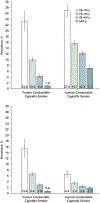Prevalence and Distribution of E-Cigarette Use Among U.S. Adults: Behavioral Risk Factor Surveillance System, 2016
- PMID: 30167658
- PMCID: PMC10534294
- DOI: 10.7326/M17-3440
Prevalence and Distribution of E-Cigarette Use Among U.S. Adults: Behavioral Risk Factor Surveillance System, 2016
Abstract
Background: Contemporary data on the prevalence of e-cigarette use in the United States are limited.
Objective: To report the prevalence and distribution of current e-cigarette use among U.S. adults in 2016.
Design: Cross-sectional.
Setting: Behavioral Risk Factor Surveillance System, 2016.
Participants: Adults aged 18 years and older.
Measurements: Prevalence of current e-cigarette use by sociodemographic groups, comorbid medical conditions, and states of residence.
Results: Of participants with information on e-cigarette use (n = 466 842), 15 240 were current e-cigarette users, representing a prevalence of 4.5%, which corresponds to 10.8 million adult e-cigarette users in the United States. Of the e-cigarette users, 15% were never-cigarette smokers. The prevalence of current e-cigarette use was highest among persons aged 18 to 24 years (9.2% [95% CI, 8.6% to 9.8%]), translating to approximately 2.8 million users in this age range. More than half the current e-cigarette users (51.2%) were younger than 35 years. In addition, the age-standardized prevalence of e-cigarette use was high among men; lesbian, gay, bisexual, and transgender (LGBT) persons; current combustible cigarette smokers; and those with chronic health conditions. The prevalence of e-cigarette use varied widely among states, with estimates ranging from 3.1% (CI, 2.3% to 4.1%) in South Dakota to 7.0% (CI, 6.0% to 8.2%) in Oklahoma.
Limitation: Data were self-reported, and no biochemical confirmation of tobacco use was available.
Conclusion: E-cigarette use is common, especially in younger adults, LGBT persons, current cigarette smokers, and persons with comorbid conditions. The prevalence of use differs across states. These contemporary estimates may inform researchers, health care policymakers, and tobacco regulators about demographic and geographic distributions of e-cigarette use.
Primary funding source: American Heart Association Tobacco Regulation and Addiction Center, which is funded by the U.S. Food and Drug Administration and National Heart, Lung, and Blood Institute.
Conflict of interest statement
Figures



Comment in
-
Monitoring the Rapidly Changing Landscape of E-Cigarettes.Ann Intern Med. 2018 Oct 2;169(7):494-495. doi: 10.7326/M18-2176. Epub 2018 Aug 28. Ann Intern Med. 2018. PMID: 30167664 No abstract available.
References
-
- Bhatnagar A, Whitsel LP, Ribisl KM, Bullen C, Chaloupka F, Piano MR, et al.; American Heart Association Advocacy Coordinating Committee, Council on Cardiovascular and Stroke Nursing, Council on Clinical Cardiology, and Council on Quality of Care and Outcomes Research. Electronic cigarettes: a policy statement from the American Heart Association. Circulation. 2014;130:1418–36. doi:10.1161/CIR.0000000000000107 - DOI - PMC - PubMed
-
- Food and Drug Administration; HHS. Deeming tobacco products to be subject to the Federal Food, Drug, and Cosmetic Act, as amended by the Family Smoking Prevention and Tobacco Control Act; restrictions on the sale and distribution of tobacco products and required warning statements for tobacco products. Final rule. Fed Regist 2016;81:28973–9106. - PubMed
-
- U.S. Department of Health and Human Services. E-cigarette use among youth and young adults: a report of the surgeon general. Accessed at https://e-cigarettes.surgeongeneral.gov/documents/2016_sgr_full_report_n... on 8 August 2018.
Publication types
MeSH terms
Grants and funding
LinkOut - more resources
Full Text Sources
Other Literature Sources
